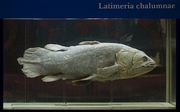Coelacanth
| Coelacanth |
|---|

|
| Scientific Classification |
|
| Genera |
|
Family Coelacanthidae
Family Mawsoniidae
Family Latimeridae
|
Coelacanths are very rare creatures (they have been given Appendix I status in the C.I.T.E.S. listings, with their speculated population of only 1,000 [1]) with much still unknown about them. They were once thought to have gone extinct until a live specimen was caught of the eastern coast of South Africa in 1938. Though they have been found in Comoros, Sulawesi (Indonesia), Kenya, Tanzania, Mozambique, Madagascar, and Greater St. Lucia Wetland Park in South Africa [2] it is still unknown whether they were individuals who simply strayed from the natural habitats in Comoros and Indonesia or they stand for living groups in the other areas [3].
Discovery
The coelacanth is a “living fossil” because it appears to be the same as a species found in fossils with no known close living “relatives [4].” Until 1938 the coelacanth was believed to have gone extinct many years ago (by the evolutionists, sixty-six million years ago [5]). In the year 1938 a man named Hendrik Goosen, a manager of a trawler fleet [6], discovered an unknown species of fish while inspecting a fishing trawl’s catch for unfamiliar marine life to use as museum specimens. He brought the bizarre specimen to Marjorie Courtney-Latimer, in the East London Harbor, in an attempt to identify the unusual fish. Upon failing to find any mention of such a fish in her books, Courtney-Latimer attempted to contact Professor James Leonard Brierley Smith, but he was away. Courtney-Latimer took the uncommon fish to the taxidermist to be preserved for Prof. Smith’s return. Upon his return, Prof. Smith immediately recognized the fish as one thought to have gone extinct and only found in fossils, the coelacanth [7]. If you wish to read the letters that Courtney-Latimer and Prof. Smith exchanged then follow this link: [8].
Anatomy
Coelacanths are bony fish that have the characteristic lobe-fins (paired rounded fins) of the taxonomic class Sarcopterygii and are the only known living species with a properly functioning intracranial joint (which serves to almost separate the front and back halves of the brain and, theoretically, help with the swallowing of the coelacanth's larger prey). Their pectoral and anal fins are both on “fleshy stalks” that are reinforced by bone. The notochord continues on through the middle of the three segments that the coelacanth’s tail is split into. The coelacanth possesses a rostral organ (an organ which is believed to act as an electric field receptor and detect other organisms in the depths of the ocean where light is scarce) that is located in the front of its skull. Coelacanths, because they tend towards the deeper parts of the ocean, have extremely light-sensitive eyes that possess a tapetum lucidum (which serves to reflect light to the retina) and will rarely be caught during the day or on nights with full moons [9].
The coelacanth bears a slightly “modified version” of cosmoid scales, a scale type that is believed to be found only on extinct fish. The coelacanth’s scales are thinner than true cosmoid scales because they lack the layer of cosmine that true cosmoid scales possess. These scales are very coarse and are often used as a substitute for sandpaper by the villagers of the Comoros. Coelacanths’ scales produce mucus as their bodies continually excrete oil that works as a laxative, rendering the fish nearly inedible unless they have been dried out and salted [10].
There are two main species of coelacanth: the Indonesian coelacanth (Latimeria menadoensis) and the Comorese coelacanth (Latimeria chalumnae). The Comorese coelacanth may reach up to two meters in length and their average weight is eighty kilograms. They come in deep shades of blue that are believed to camouflage them from their prey. The Indonesian variety comes instead in shades of brown [11].
Reproduction
Not much is known about the actual reproductive processes of the coelacanth, but they are believed to be to remain sexually immature until they reach twenty years of age. Female coelacanths give birth to between five and twenty-five live young, which are immediately capable of surviving on their own. The average gestation time of the coelacanth is roughly thirteen months [12].
Ecology
Coelacanths are opportunistic drift-feeders that consume cuttlefish, small sharks, squid, snipe eels and other such small fish [13] of their habitat by use of a suction action of the jaw and the intracranial joint [14]. They are found in depths usually ranging between ninety to two hundred meters below sea level, though they me be found as deep as seven hundred meters. Most likely through the use of their rostral organ, coelacanths are capable of swimming head down, backwards, and belly up to detect their prey [15]. Scientists are as yet unable to explain the coelacanths acute sense of timing (groups of coelacanths were observed leaving the caves of their habitat and the same time each night) and their expert coastal navigational skills [16].
Gallery
Related References
- Coelacanth by Wikipedia
- Coelacanth: The fish out of time Set up and Maintained by: Jerome F. Hamlin, Graphics and Web Design by: Erik Pedersen, Publisher: Third Wave Media Inc.
- Moment of Discovery By: Peter Tyson, Website: Nova





